Nursing Theory: Analyzing Virginia Henderson's Nursing Need Theory
VerifiedAdded on 2021/04/22
|9
|1669
|189
Essay
AI Summary
This essay critically analyzes Virginia Henderson's Nursing Need Theory, a foundational model in nursing that emphasizes patient independence and holistic care. The paper explores the theory's key components, including the individual, environment, health, and nursing, detailing how these elements contribute to a patient's well-being. It examines the advantages and disadvantages of Henderson's approach, highlighting its impact on nursing education and practice. The analysis covers the theory's application, key components, and its relevance in promoting patient-centered care. The essay also provides a critical evaluation of the theory, discussing its strengths and limitations in the context of modern healthcare, and its congruence with education and the role of a nurse educator. The essay concludes by emphasizing the importance of Henderson's Nursing Need Theory in shaping nursing practices and its enduring influence on the field.
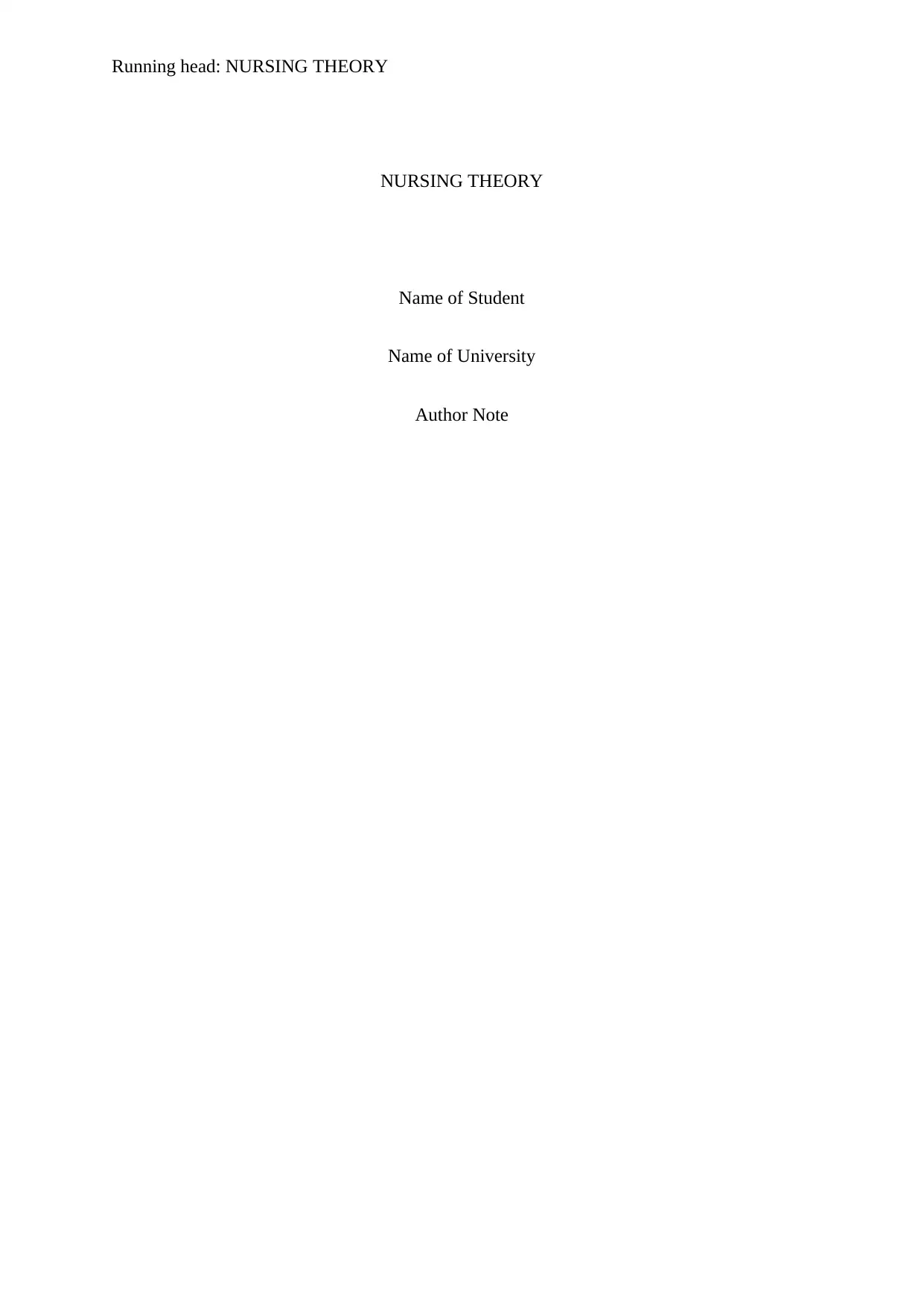
Running head: NURSING THEORY
NURSING THEORY
Name of Student
Name of University
Author Note
NURSING THEORY
Name of Student
Name of University
Author Note
Paraphrase This Document
Need a fresh take? Get an instant paraphrase of this document with our AI Paraphraser
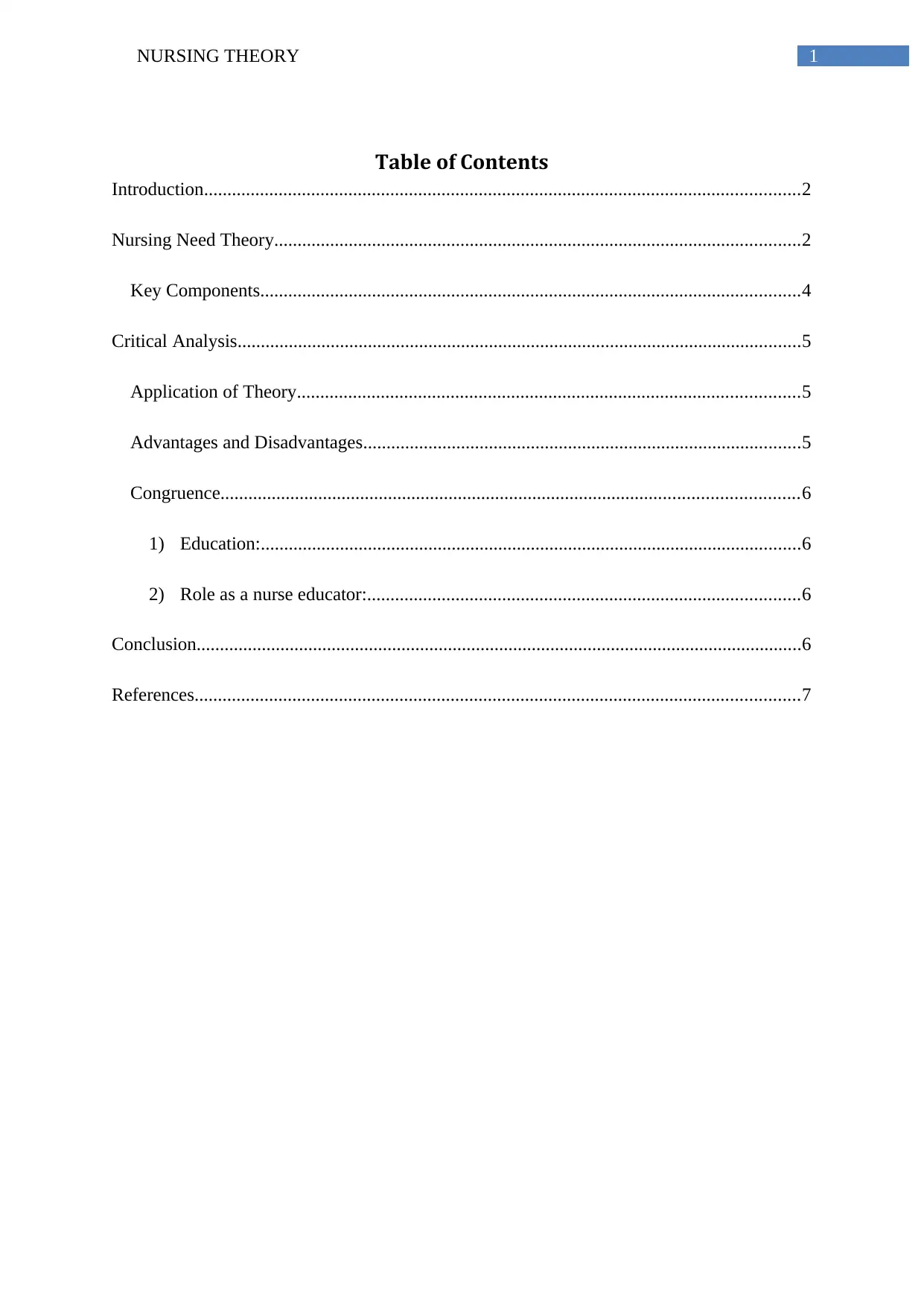
1NURSING THEORY
Table of Contents
Introduction................................................................................................................................2
Nursing Need Theory.................................................................................................................2
Key Components....................................................................................................................4
Critical Analysis.........................................................................................................................5
Application of Theory............................................................................................................5
Advantages and Disadvantages..............................................................................................5
Congruence............................................................................................................................6
1) Education:....................................................................................................................6
2) Role as a nurse educator:.............................................................................................6
Conclusion..................................................................................................................................6
References..................................................................................................................................7
Table of Contents
Introduction................................................................................................................................2
Nursing Need Theory.................................................................................................................2
Key Components....................................................................................................................4
Critical Analysis.........................................................................................................................5
Application of Theory............................................................................................................5
Advantages and Disadvantages..............................................................................................5
Congruence............................................................................................................................6
1) Education:....................................................................................................................6
2) Role as a nurse educator:.............................................................................................6
Conclusion..................................................................................................................................6
References..................................................................................................................................7
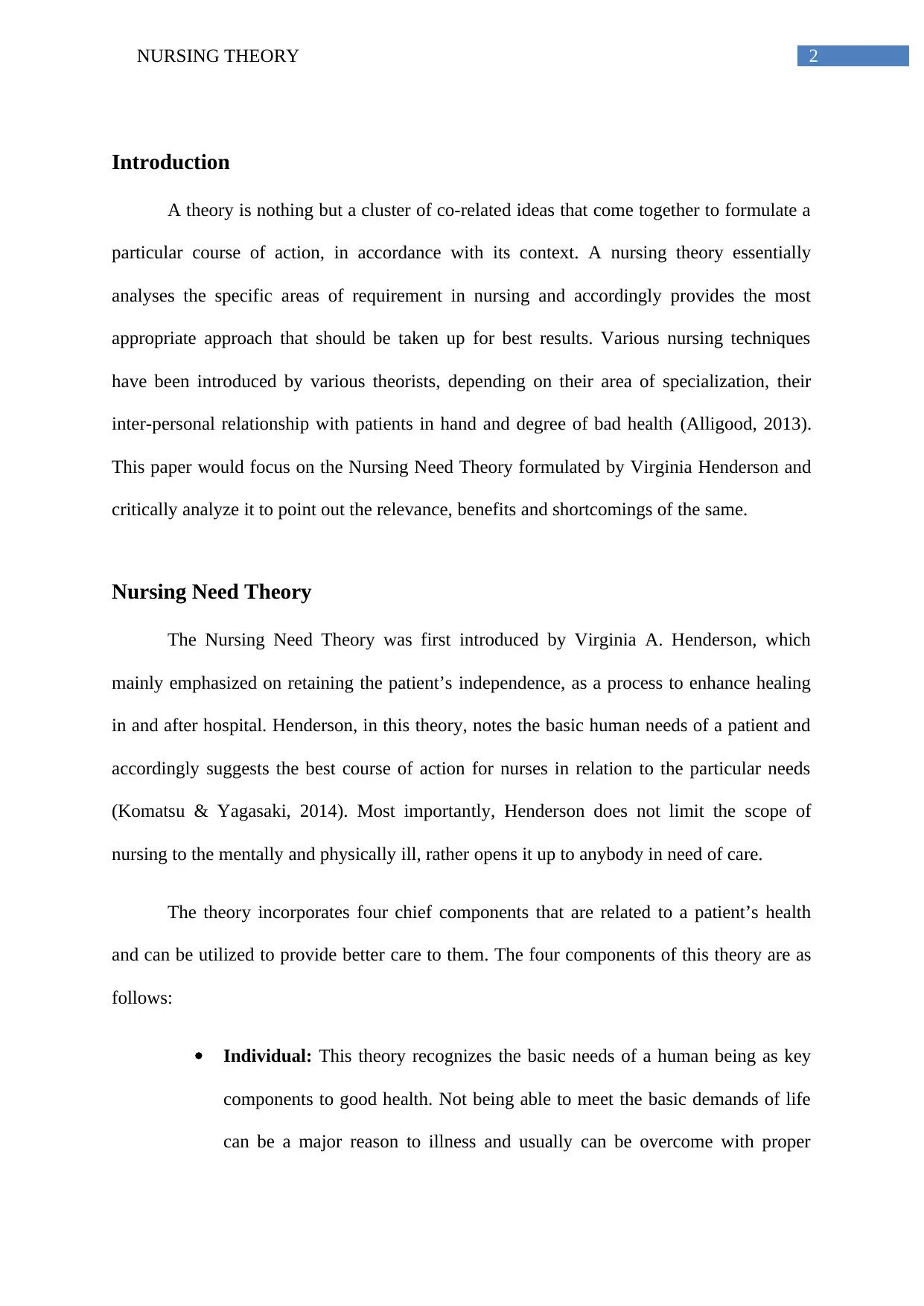
2NURSING THEORY
Introduction
A theory is nothing but a cluster of co-related ideas that come together to formulate a
particular course of action, in accordance with its context. A nursing theory essentially
analyses the specific areas of requirement in nursing and accordingly provides the most
appropriate approach that should be taken up for best results. Various nursing techniques
have been introduced by various theorists, depending on their area of specialization, their
inter-personal relationship with patients in hand and degree of bad health (Alligood, 2013).
This paper would focus on the Nursing Need Theory formulated by Virginia Henderson and
critically analyze it to point out the relevance, benefits and shortcomings of the same.
Nursing Need Theory
The Nursing Need Theory was first introduced by Virginia A. Henderson, which
mainly emphasized on retaining the patient’s independence, as a process to enhance healing
in and after hospital. Henderson, in this theory, notes the basic human needs of a patient and
accordingly suggests the best course of action for nurses in relation to the particular needs
(Komatsu & Yagasaki, 2014). Most importantly, Henderson does not limit the scope of
nursing to the mentally and physically ill, rather opens it up to anybody in need of care.
The theory incorporates four chief components that are related to a patient’s health
and can be utilized to provide better care to them. The four components of this theory are as
follows:
Individual: This theory recognizes the basic needs of a human being as key
components to good health. Not being able to meet the basic demands of life
can be a major reason to illness and usually can be overcome with proper
Introduction
A theory is nothing but a cluster of co-related ideas that come together to formulate a
particular course of action, in accordance with its context. A nursing theory essentially
analyses the specific areas of requirement in nursing and accordingly provides the most
appropriate approach that should be taken up for best results. Various nursing techniques
have been introduced by various theorists, depending on their area of specialization, their
inter-personal relationship with patients in hand and degree of bad health (Alligood, 2013).
This paper would focus on the Nursing Need Theory formulated by Virginia Henderson and
critically analyze it to point out the relevance, benefits and shortcomings of the same.
Nursing Need Theory
The Nursing Need Theory was first introduced by Virginia A. Henderson, which
mainly emphasized on retaining the patient’s independence, as a process to enhance healing
in and after hospital. Henderson, in this theory, notes the basic human needs of a patient and
accordingly suggests the best course of action for nurses in relation to the particular needs
(Komatsu & Yagasaki, 2014). Most importantly, Henderson does not limit the scope of
nursing to the mentally and physically ill, rather opens it up to anybody in need of care.
The theory incorporates four chief components that are related to a patient’s health
and can be utilized to provide better care to them. The four components of this theory are as
follows:
Individual: This theory recognizes the basic needs of a human being as key
components to good health. Not being able to meet the basic demands of life
can be a major reason to illness and usually can be overcome with proper
⊘ This is a preview!⊘
Do you want full access?
Subscribe today to unlock all pages.

Trusted by 1+ million students worldwide
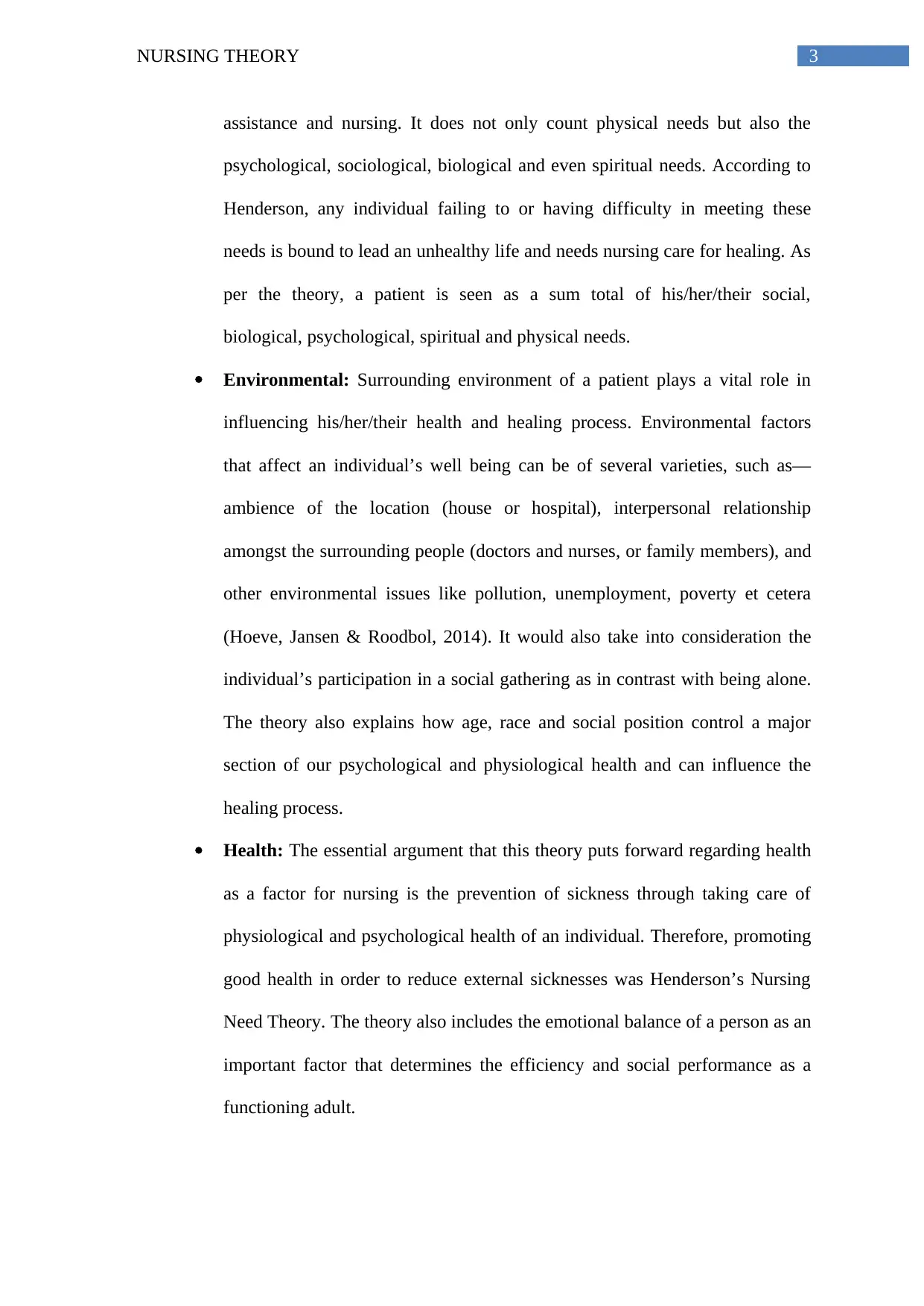
3NURSING THEORY
assistance and nursing. It does not only count physical needs but also the
psychological, sociological, biological and even spiritual needs. According to
Henderson, any individual failing to or having difficulty in meeting these
needs is bound to lead an unhealthy life and needs nursing care for healing. As
per the theory, a patient is seen as a sum total of his/her/their social,
biological, psychological, spiritual and physical needs.
Environmental: Surrounding environment of a patient plays a vital role in
influencing his/her/their health and healing process. Environmental factors
that affect an individual’s well being can be of several varieties, such as—
ambience of the location (house or hospital), interpersonal relationship
amongst the surrounding people (doctors and nurses, or family members), and
other environmental issues like pollution, unemployment, poverty et cetera
(Hoeve, Jansen & Roodbol, 2014). It would also take into consideration the
individual’s participation in a social gathering as in contrast with being alone.
The theory also explains how age, race and social position control a major
section of our psychological and physiological health and can influence the
healing process.
Health: The essential argument that this theory puts forward regarding health
as a factor for nursing is the prevention of sickness through taking care of
physiological and psychological health of an individual. Therefore, promoting
good health in order to reduce external sicknesses was Henderson’s Nursing
Need Theory. The theory also includes the emotional balance of a person as an
important factor that determines the efficiency and social performance as a
functioning adult.
assistance and nursing. It does not only count physical needs but also the
psychological, sociological, biological and even spiritual needs. According to
Henderson, any individual failing to or having difficulty in meeting these
needs is bound to lead an unhealthy life and needs nursing care for healing. As
per the theory, a patient is seen as a sum total of his/her/their social,
biological, psychological, spiritual and physical needs.
Environmental: Surrounding environment of a patient plays a vital role in
influencing his/her/their health and healing process. Environmental factors
that affect an individual’s well being can be of several varieties, such as—
ambience of the location (house or hospital), interpersonal relationship
amongst the surrounding people (doctors and nurses, or family members), and
other environmental issues like pollution, unemployment, poverty et cetera
(Hoeve, Jansen & Roodbol, 2014). It would also take into consideration the
individual’s participation in a social gathering as in contrast with being alone.
The theory also explains how age, race and social position control a major
section of our psychological and physiological health and can influence the
healing process.
Health: The essential argument that this theory puts forward regarding health
as a factor for nursing is the prevention of sickness through taking care of
physiological and psychological health of an individual. Therefore, promoting
good health in order to reduce external sicknesses was Henderson’s Nursing
Need Theory. The theory also includes the emotional balance of a person as an
important factor that determines the efficiency and social performance as a
functioning adult.
Paraphrase This Document
Need a fresh take? Get an instant paraphrase of this document with our AI Paraphraser
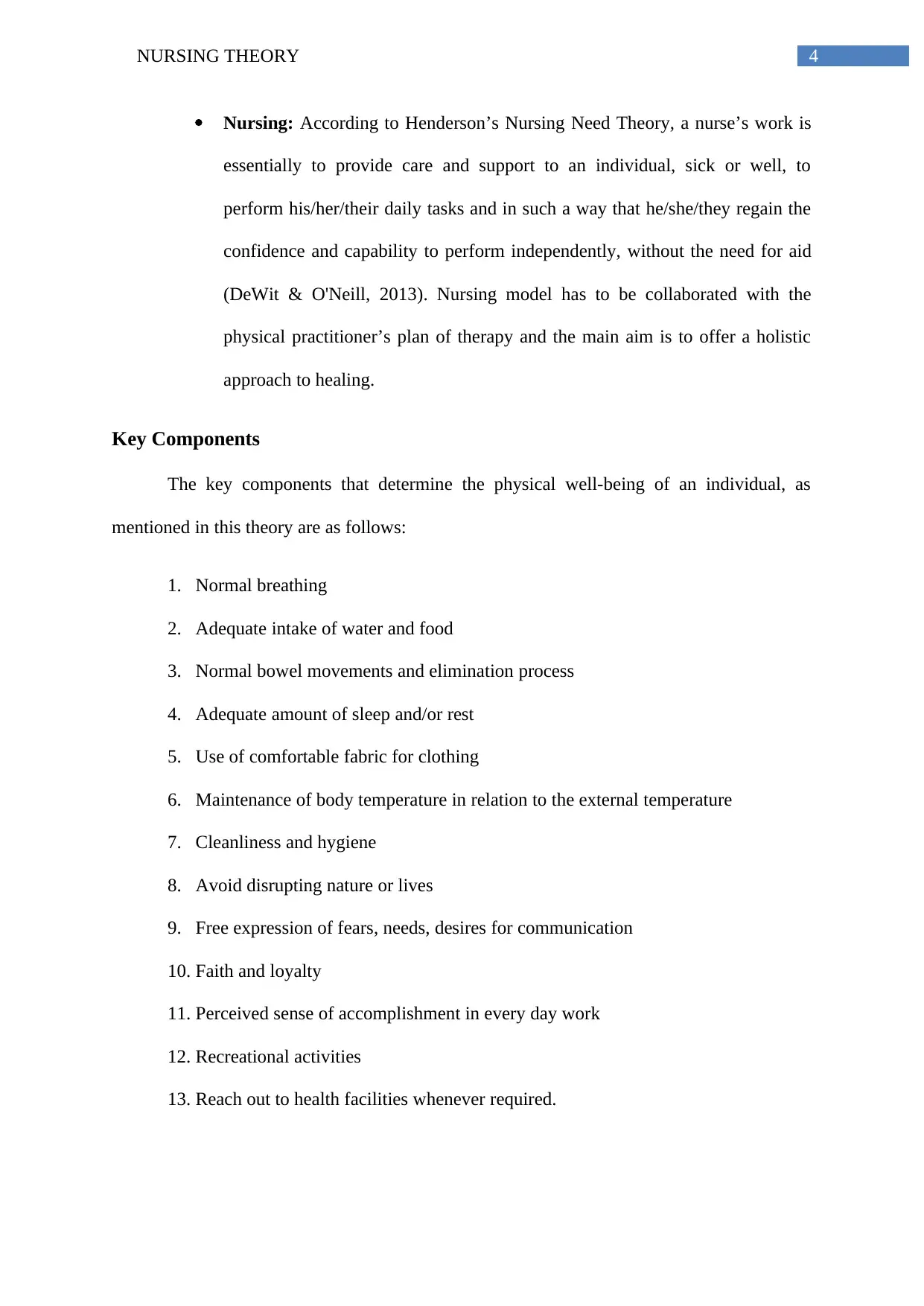
4NURSING THEORY
Nursing: According to Henderson’s Nursing Need Theory, a nurse’s work is
essentially to provide care and support to an individual, sick or well, to
perform his/her/their daily tasks and in such a way that he/she/they regain the
confidence and capability to perform independently, without the need for aid
(DeWit & O'Neill, 2013). Nursing model has to be collaborated with the
physical practitioner’s plan of therapy and the main aim is to offer a holistic
approach to healing.
Key Components
The key components that determine the physical well-being of an individual, as
mentioned in this theory are as follows:
1. Normal breathing
2. Adequate intake of water and food
3. Normal bowel movements and elimination process
4. Adequate amount of sleep and/or rest
5. Use of comfortable fabric for clothing
6. Maintenance of body temperature in relation to the external temperature
7. Cleanliness and hygiene
8. Avoid disrupting nature or lives
9. Free expression of fears, needs, desires for communication
10. Faith and loyalty
11. Perceived sense of accomplishment in every day work
12. Recreational activities
13. Reach out to health facilities whenever required.
Nursing: According to Henderson’s Nursing Need Theory, a nurse’s work is
essentially to provide care and support to an individual, sick or well, to
perform his/her/their daily tasks and in such a way that he/she/they regain the
confidence and capability to perform independently, without the need for aid
(DeWit & O'Neill, 2013). Nursing model has to be collaborated with the
physical practitioner’s plan of therapy and the main aim is to offer a holistic
approach to healing.
Key Components
The key components that determine the physical well-being of an individual, as
mentioned in this theory are as follows:
1. Normal breathing
2. Adequate intake of water and food
3. Normal bowel movements and elimination process
4. Adequate amount of sleep and/or rest
5. Use of comfortable fabric for clothing
6. Maintenance of body temperature in relation to the external temperature
7. Cleanliness and hygiene
8. Avoid disrupting nature or lives
9. Free expression of fears, needs, desires for communication
10. Faith and loyalty
11. Perceived sense of accomplishment in every day work
12. Recreational activities
13. Reach out to health facilities whenever required.
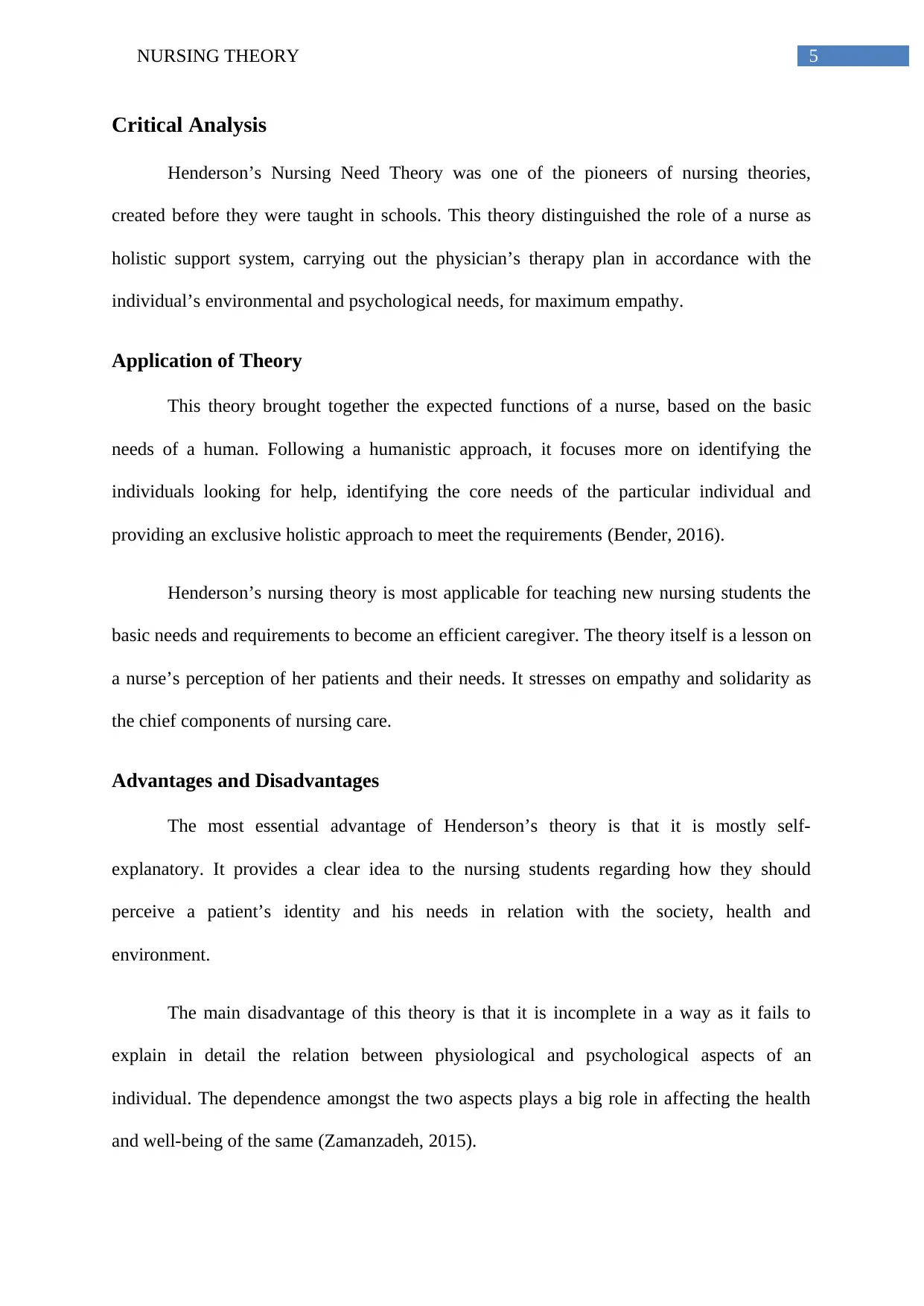
5NURSING THEORY
Critical Analysis
Henderson’s Nursing Need Theory was one of the pioneers of nursing theories,
created before they were taught in schools. This theory distinguished the role of a nurse as
holistic support system, carrying out the physician’s therapy plan in accordance with the
individual’s environmental and psychological needs, for maximum empathy.
Application of Theory
This theory brought together the expected functions of a nurse, based on the basic
needs of a human. Following a humanistic approach, it focuses more on identifying the
individuals looking for help, identifying the core needs of the particular individual and
providing an exclusive holistic approach to meet the requirements (Bender, 2016).
Henderson’s nursing theory is most applicable for teaching new nursing students the
basic needs and requirements to become an efficient caregiver. The theory itself is a lesson on
a nurse’s perception of her patients and their needs. It stresses on empathy and solidarity as
the chief components of nursing care.
Advantages and Disadvantages
The most essential advantage of Henderson’s theory is that it is mostly self-
explanatory. It provides a clear idea to the nursing students regarding how they should
perceive a patient’s identity and his needs in relation with the society, health and
environment.
The main disadvantage of this theory is that it is incomplete in a way as it fails to
explain in detail the relation between physiological and psychological aspects of an
individual. The dependence amongst the two aspects plays a big role in affecting the health
and well-being of the same (Zamanzadeh, 2015).
Critical Analysis
Henderson’s Nursing Need Theory was one of the pioneers of nursing theories,
created before they were taught in schools. This theory distinguished the role of a nurse as
holistic support system, carrying out the physician’s therapy plan in accordance with the
individual’s environmental and psychological needs, for maximum empathy.
Application of Theory
This theory brought together the expected functions of a nurse, based on the basic
needs of a human. Following a humanistic approach, it focuses more on identifying the
individuals looking for help, identifying the core needs of the particular individual and
providing an exclusive holistic approach to meet the requirements (Bender, 2016).
Henderson’s nursing theory is most applicable for teaching new nursing students the
basic needs and requirements to become an efficient caregiver. The theory itself is a lesson on
a nurse’s perception of her patients and their needs. It stresses on empathy and solidarity as
the chief components of nursing care.
Advantages and Disadvantages
The most essential advantage of Henderson’s theory is that it is mostly self-
explanatory. It provides a clear idea to the nursing students regarding how they should
perceive a patient’s identity and his needs in relation with the society, health and
environment.
The main disadvantage of this theory is that it is incomplete in a way as it fails to
explain in detail the relation between physiological and psychological aspects of an
individual. The dependence amongst the two aspects plays a big role in affecting the health
and well-being of the same (Zamanzadeh, 2015).
⊘ This is a preview!⊘
Do you want full access?
Subscribe today to unlock all pages.

Trusted by 1+ million students worldwide
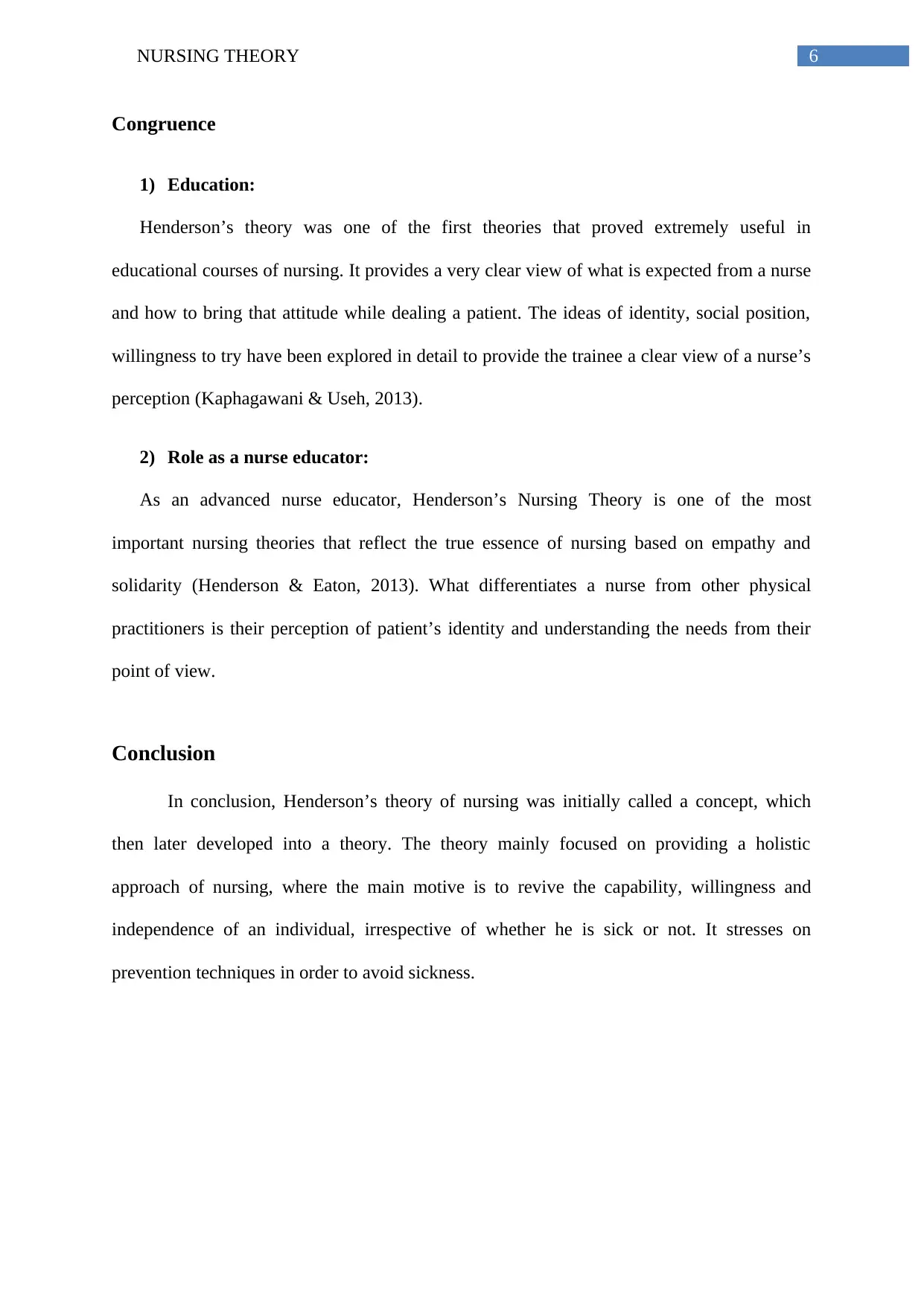
6NURSING THEORY
Congruence
1) Education:
Henderson’s theory was one of the first theories that proved extremely useful in
educational courses of nursing. It provides a very clear view of what is expected from a nurse
and how to bring that attitude while dealing a patient. The ideas of identity, social position,
willingness to try have been explored in detail to provide the trainee a clear view of a nurse’s
perception (Kaphagawani & Useh, 2013).
2) Role as a nurse educator:
As an advanced nurse educator, Henderson’s Nursing Theory is one of the most
important nursing theories that reflect the true essence of nursing based on empathy and
solidarity (Henderson & Eaton, 2013). What differentiates a nurse from other physical
practitioners is their perception of patient’s identity and understanding the needs from their
point of view.
Conclusion
In conclusion, Henderson’s theory of nursing was initially called a concept, which
then later developed into a theory. The theory mainly focused on providing a holistic
approach of nursing, where the main motive is to revive the capability, willingness and
independence of an individual, irrespective of whether he is sick or not. It stresses on
prevention techniques in order to avoid sickness.
Congruence
1) Education:
Henderson’s theory was one of the first theories that proved extremely useful in
educational courses of nursing. It provides a very clear view of what is expected from a nurse
and how to bring that attitude while dealing a patient. The ideas of identity, social position,
willingness to try have been explored in detail to provide the trainee a clear view of a nurse’s
perception (Kaphagawani & Useh, 2013).
2) Role as a nurse educator:
As an advanced nurse educator, Henderson’s Nursing Theory is one of the most
important nursing theories that reflect the true essence of nursing based on empathy and
solidarity (Henderson & Eaton, 2013). What differentiates a nurse from other physical
practitioners is their perception of patient’s identity and understanding the needs from their
point of view.
Conclusion
In conclusion, Henderson’s theory of nursing was initially called a concept, which
then later developed into a theory. The theory mainly focused on providing a holistic
approach of nursing, where the main motive is to revive the capability, willingness and
independence of an individual, irrespective of whether he is sick or not. It stresses on
prevention techniques in order to avoid sickness.
Paraphrase This Document
Need a fresh take? Get an instant paraphrase of this document with our AI Paraphraser
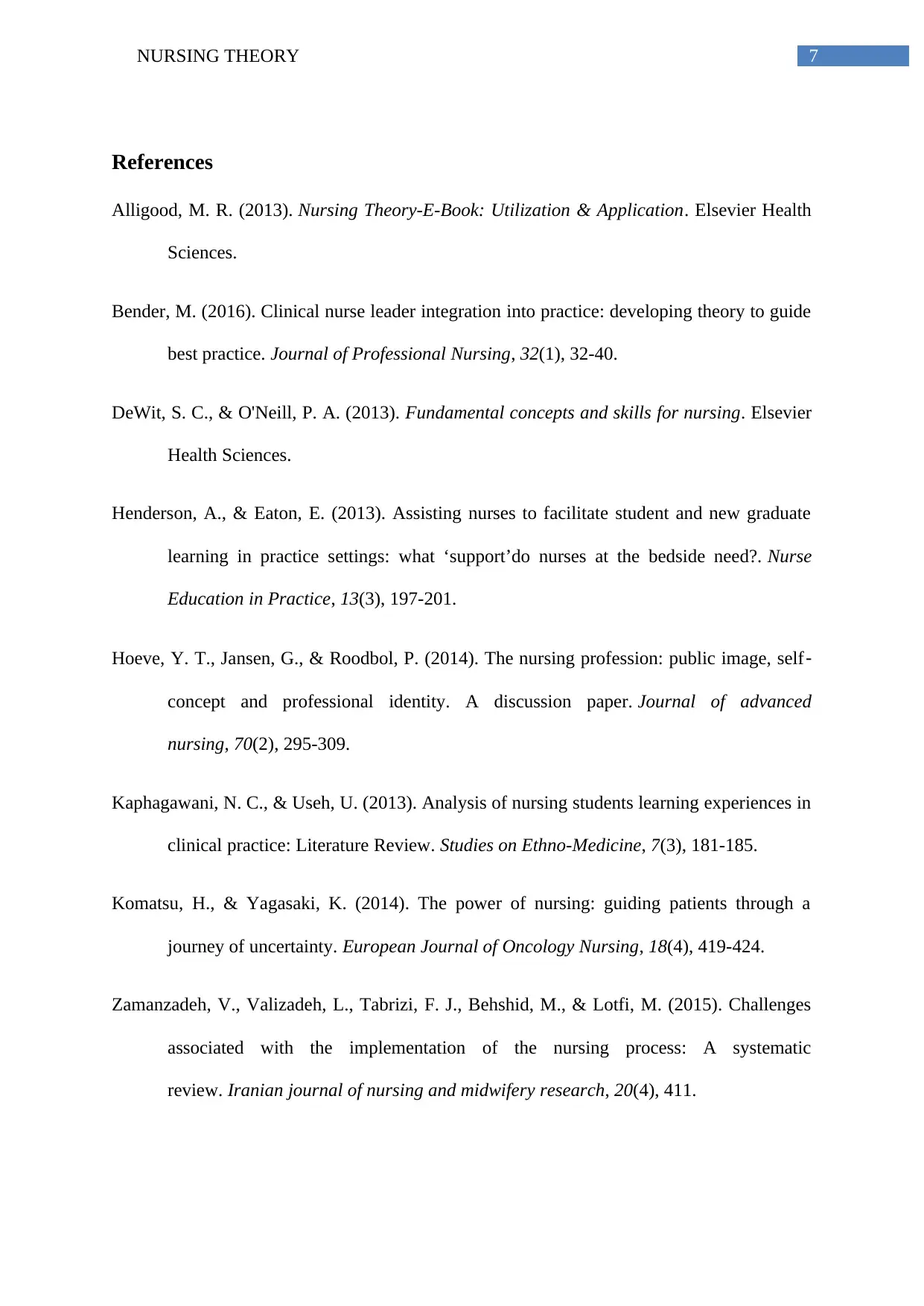
7NURSING THEORY
References
Alligood, M. R. (2013). Nursing Theory-E-Book: Utilization & Application. Elsevier Health
Sciences.
Bender, M. (2016). Clinical nurse leader integration into practice: developing theory to guide
best practice. Journal of Professional Nursing, 32(1), 32-40.
DeWit, S. C., & O'Neill, P. A. (2013). Fundamental concepts and skills for nursing. Elsevier
Health Sciences.
Henderson, A., & Eaton, E. (2013). Assisting nurses to facilitate student and new graduate
learning in practice settings: what ‘support’do nurses at the bedside need?. Nurse
Education in Practice, 13(3), 197-201.
Hoeve, Y. T., Jansen, G., & Roodbol, P. (2014). The nursing profession: public image, self‐
concept and professional identity. A discussion paper. Journal of advanced
nursing, 70(2), 295-309.
Kaphagawani, N. C., & Useh, U. (2013). Analysis of nursing students learning experiences in
clinical practice: Literature Review. Studies on Ethno-Medicine, 7(3), 181-185.
Komatsu, H., & Yagasaki, K. (2014). The power of nursing: guiding patients through a
journey of uncertainty. European Journal of Oncology Nursing, 18(4), 419-424.
Zamanzadeh, V., Valizadeh, L., Tabrizi, F. J., Behshid, M., & Lotfi, M. (2015). Challenges
associated with the implementation of the nursing process: A systematic
review. Iranian journal of nursing and midwifery research, 20(4), 411.
References
Alligood, M. R. (2013). Nursing Theory-E-Book: Utilization & Application. Elsevier Health
Sciences.
Bender, M. (2016). Clinical nurse leader integration into practice: developing theory to guide
best practice. Journal of Professional Nursing, 32(1), 32-40.
DeWit, S. C., & O'Neill, P. A. (2013). Fundamental concepts and skills for nursing. Elsevier
Health Sciences.
Henderson, A., & Eaton, E. (2013). Assisting nurses to facilitate student and new graduate
learning in practice settings: what ‘support’do nurses at the bedside need?. Nurse
Education in Practice, 13(3), 197-201.
Hoeve, Y. T., Jansen, G., & Roodbol, P. (2014). The nursing profession: public image, self‐
concept and professional identity. A discussion paper. Journal of advanced
nursing, 70(2), 295-309.
Kaphagawani, N. C., & Useh, U. (2013). Analysis of nursing students learning experiences in
clinical practice: Literature Review. Studies on Ethno-Medicine, 7(3), 181-185.
Komatsu, H., & Yagasaki, K. (2014). The power of nursing: guiding patients through a
journey of uncertainty. European Journal of Oncology Nursing, 18(4), 419-424.
Zamanzadeh, V., Valizadeh, L., Tabrizi, F. J., Behshid, M., & Lotfi, M. (2015). Challenges
associated with the implementation of the nursing process: A systematic
review. Iranian journal of nursing and midwifery research, 20(4), 411.
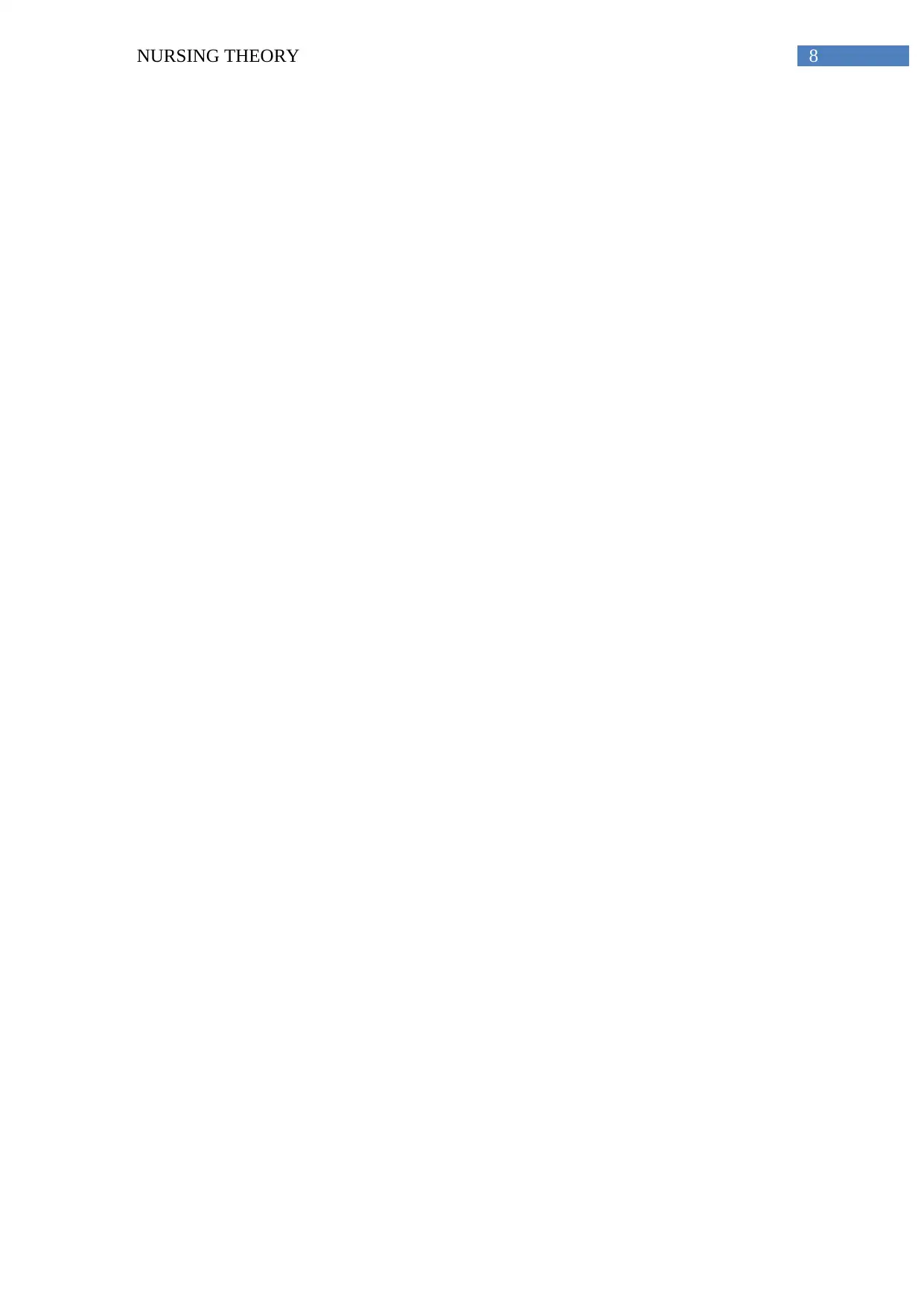
8NURSING THEORY
⊘ This is a preview!⊘
Do you want full access?
Subscribe today to unlock all pages.

Trusted by 1+ million students worldwide
1 out of 9
Related Documents
Your All-in-One AI-Powered Toolkit for Academic Success.
+13062052269
info@desklib.com
Available 24*7 on WhatsApp / Email
![[object Object]](/_next/static/media/star-bottom.7253800d.svg)
Unlock your academic potential
Copyright © 2020–2025 A2Z Services. All Rights Reserved. Developed and managed by ZUCOL.




